Laparotomy is an open surgical exploration of the abdomen, usually through a single large incision. Laparoscopy is surgical exploration and interventions performed through ports placed in small incisions with a camera and long instruments. Laparoscopy offers the advantage of being minimally invasive, but it misses the tactile component of abdominal exploration for the surgeon. Both techniques have their applications, advantages, and disadvantages, and a surgeon should be familiar and comfortable with both techniques.
Last updated: Jan 17, 2024
The surgeon must be familiar with the anatomical landmarks and important corresponding structures of the abdomen to avoid iatrogenic Iatrogenic Any adverse condition in a patient occurring as the result of treatment by a physician, surgeon, or other health professional, especially infections acquired by a patient during the course of treatment. Anterior Cord Syndrome injury to these structures, especially in emergency situations.
Boundaries of the abdomen:
Surface landmarks:
The 4 quadrants of the abdomen: The abdomen is divided into 4 quadrants with the umbilicus in the center:
The 9 regions of the abdomen: The abdomen is divided into 9 regions by 3 lines/planes:
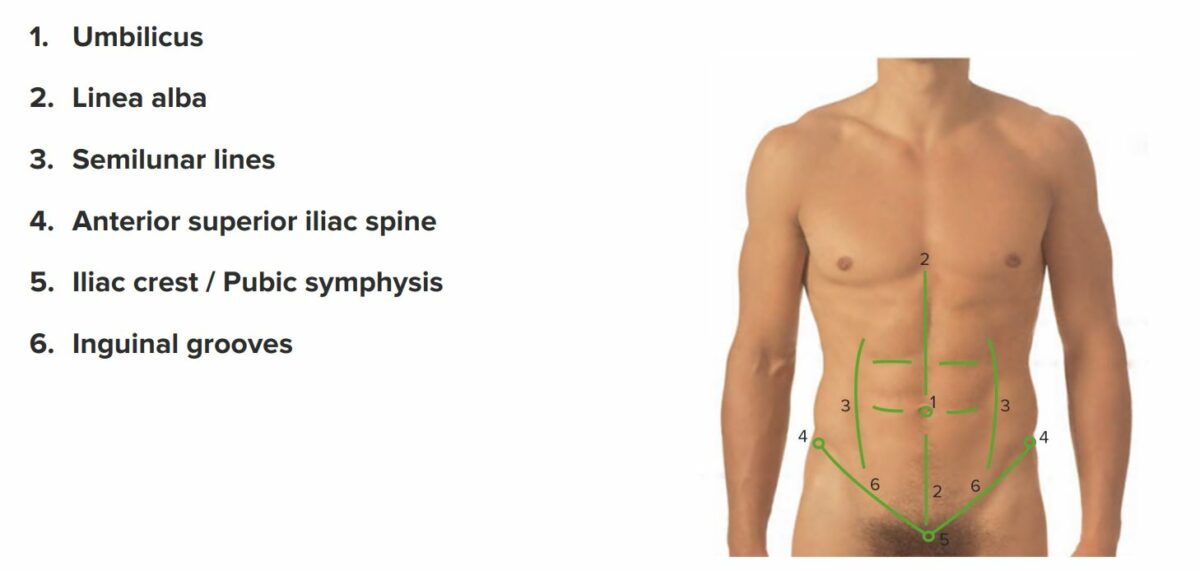
Superficial anatomical landmarks of the abdomen
Image by Lecturio. License: CC BY-NC-SA 4.0
Regions of the abdomen
Image by Lecturio.
Regions of the abdomen and their respective organs
Image by Lecturio.Anterolateral: in order (from superficial to deep):
Differences above and below the arcuate line (located approximately ⅓ the distance from the umbilicus to the pubic crest):
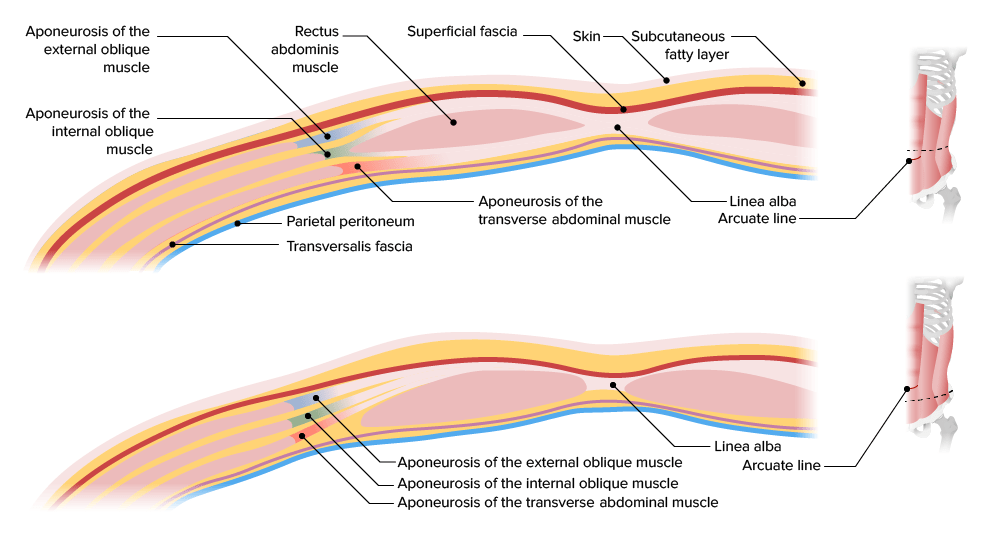
Layers of the internal abdominal wall:
Note that above the arcuate line, the posterior lamina of the internal oblique and the entire aponeurosis of the transverse abdominal muscle run posterior to the rectus abdominis. However, inferior to the arcuate line, the entire aponeurosis of the external obliques, the internal obliques, and the transverse abdominal muscles run anterior to the rectus. Only the transversalis fascia and the parietal peritoneum run posteriorly.
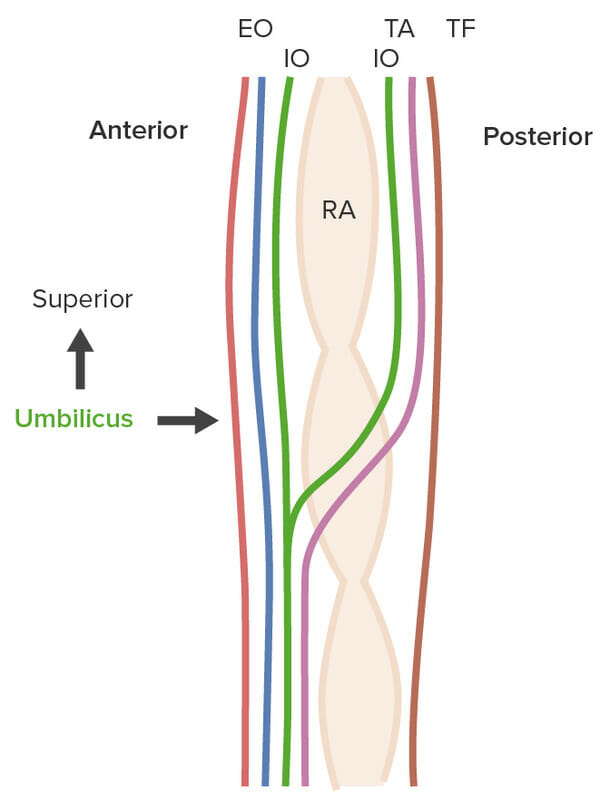
Lateral view of the layers of the anterior abdominal wall above and below the arcuate line:
Above the arcuate line, the subcutaneous fascia (red), the entire aponeurosis of the external oblique (EO, blue), and the anterior lamina of the internal oblique (IO, green) all run anterior to the rectus abdominis (RA) muscle. The posterior lamina of the internal oblique (green), the transverse abdominal muscle (TA, pink), and the transversalis fascia (TF, brown), however, run posterior to the RA muscle. Below the arcuate line (located approximately ⅓ the distance between the umbilicus and the pubic crest), the entire aponeurosis of the external oblique (blue), internal oblique (green), and transverse abdominal muscles (pink) run anterior to the RA muscle. Only the transversalis fascia (brown) runs posteriorly.
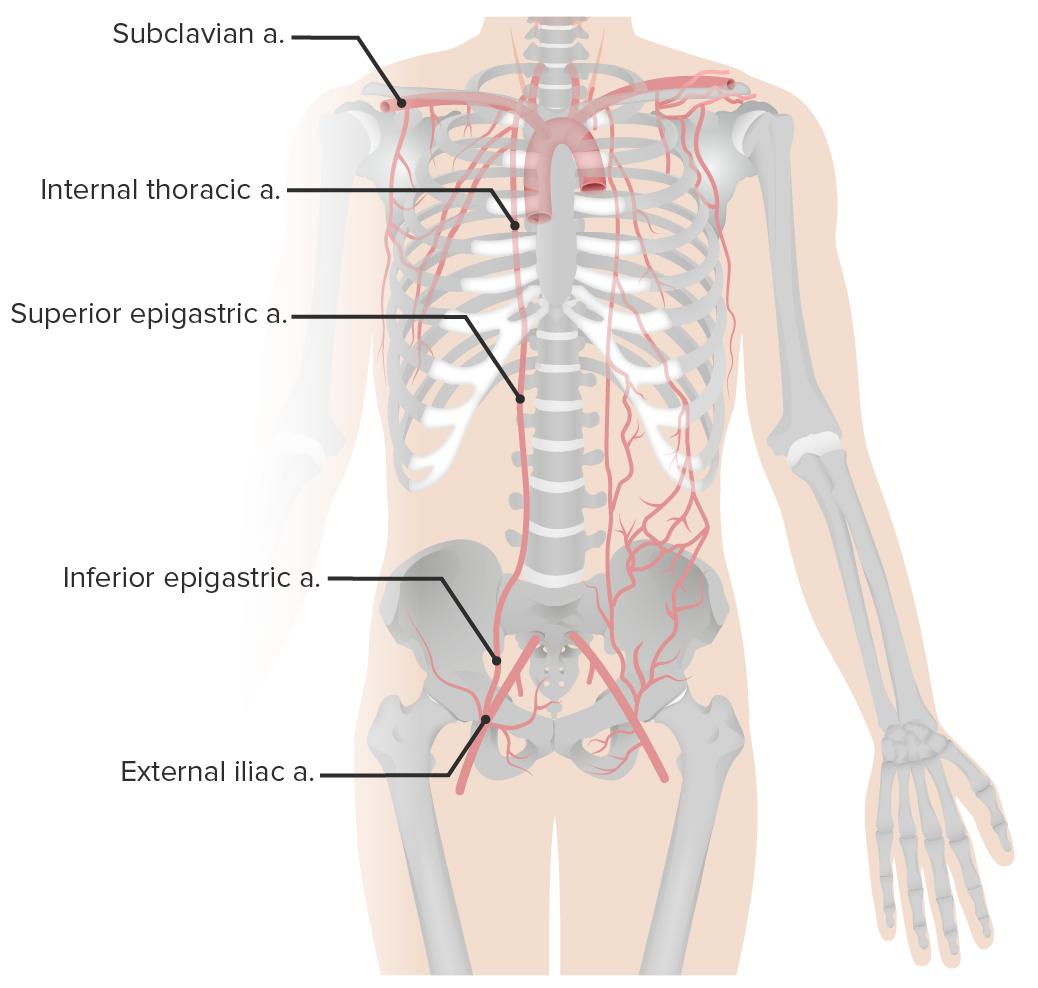
Arterial supply of the abdominal wall
a.: artery
Nerves running between the internal oblique Internal oblique Muscles of the anterolateral abdominal wall consisting of the external oblique and the internal oblique muscles. The external abdominal oblique muscle fibers extend from lower thoracic ribs to the linea alba and the iliac crest. The internal abdominal oblique extend superomedially beneath the external oblique muscles. Anterior Abdominal Wall: Anatomy and transverse abdominal layers:
Abdominal dermatomes Dermatomes Spinal Cord: Anatomy:
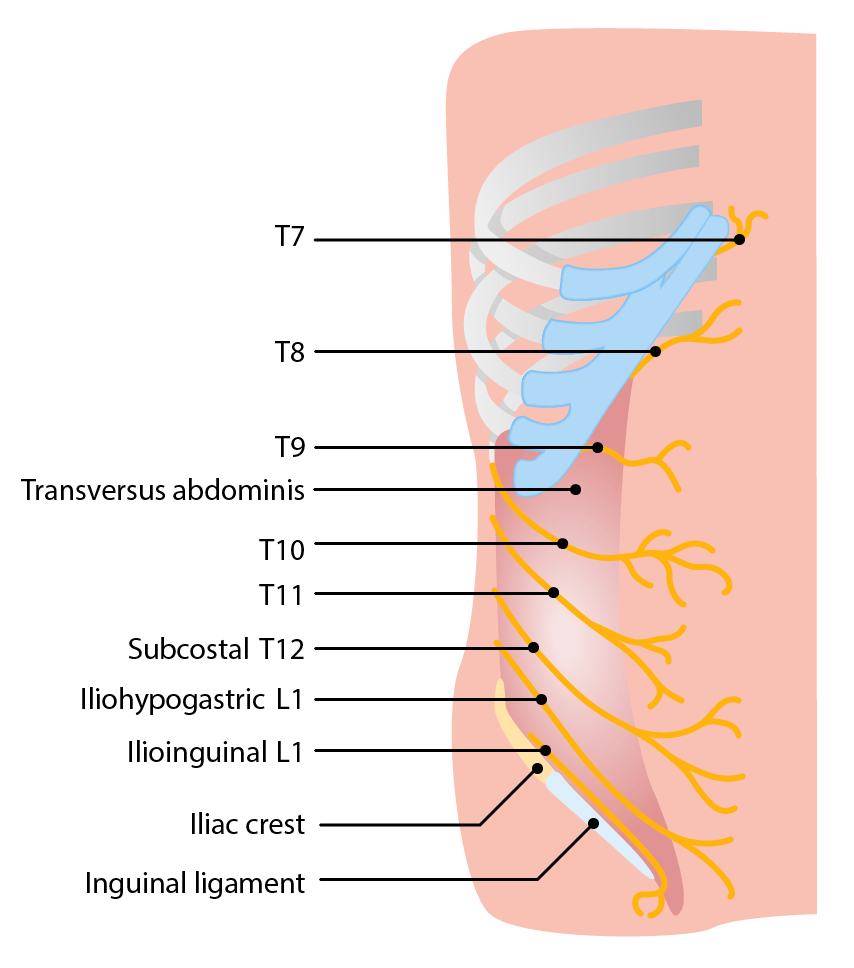
Nerves innervating the anterior abdominal wall:
The nerves run between the internal oblique and the transversus abdominis layers.

Abdominal dermatomes:
The abdomen is primarily innervated by the anterior rami of nerves, which exit the spinal cord at T7‒L1.
The majority of abdominal procedures nowadays could be performed with either the open or the laparoscopic approach. Laparoscopic approaches are generally preferred when possible
Laparoscopy has become the standard of care Standard of care The minimum acceptable patient care, based on statutes, court decisions, policies, or professional guidelines. Malpractice for many procedures because it consistently yields more favorable outcomes when it can be performed safely in place of laparotomy.
Factors to take into consideration:
There are no absolute contraindications Contraindications A condition or factor associated with a recipient that makes the use of a drug, procedure, or physical agent improper or inadvisable. Contraindications may be absolute (life threatening) or relative (higher risk of complications in which benefits may outweigh risks). Noninvasive Ventilation to exploratory laparotomy; it is commonly performed under emergent conditions.
Laparotomy:

Types of midline laparotomies
Image by Lecturio. License: CC BY-NC-SA 4.0| Direction | Incision | Description | Common example of use |
|---|---|---|---|
| Longitudinal | Midline | On the midline | Trauma procedures, cancers |
| Paramedian | 2–5 cm to the left or right of the midline | Unilateral visceral procedures: kidneys Kidneys The kidneys are a pair of bean-shaped organs located retroperitoneally against the posterior wall of the abdomen on either side of the spine. As part of the urinary tract, the kidneys are responsible for blood filtration and excretion of water-soluble waste in the urine. Kidneys: Anatomy, adrenal glands Adrenal Glands The adrenal glands are a pair of retroperitoneal endocrine glands located above the kidneys. The outer parenchyma is called the adrenal cortex and has 3 distinct zones, each with its own secretory products. Beneath the cortex lies the adrenal medulla, which secretes catecholamines involved in the fight-or-flight response. Adrenal Glands: Anatomy, and spleen Spleen The spleen is the largest lymphoid organ in the body, located in the LUQ of the abdomen, superior to the left kidney and posterior to the stomach at the level of the 9th-11th ribs just below the diaphragm. The spleen is highly vascular and acts as an important blood filter, cleansing the blood of pathogens and damaged erythrocytes. Spleen: Anatomy | |
| Pararectus (Battle incision) | On the lateral border of the rectus abdominis Rectus Abdominis A long flat muscle that extends along the whole length of both sides of the abdomen. It flexes the vertebral column, particularly the lumbar portion; it also tenses the anterior abdominal wall and assists in compressing the abdominal contents. It is frequently the site of hematomas. In reconstructive surgery it is often used for the creation of myocutaneous flaps. Anterior Abdominal Wall: Anatomy muscle | Open appendectomy Open Appendectomy Appendectomy (uncommon) | |
| Oblique | McBurney’s incision McBurney’s Incision Appendectomy | Obliquely, on McBurney’s point McBurney’s point Appendicitis | Open appendectomy Open Appendectomy Appendectomy (most common) |
| Subcostal (Kocher) | Below a costal margin | Liver Liver The liver is the largest gland in the human body. The liver is found in the superior right quadrant of the abdomen and weighs approximately 1.5 kilograms. Its main functions are detoxification, metabolism, nutrient storage (e.g., iron and vitamins), synthesis of coagulation factors, formation of bile, filtration, and storage of blood. Liver: Anatomy, gallbladder Gallbladder The gallbladder is a pear-shaped sac, located directly beneath the liver, that sits on top of the superior part of the duodenum. The primary functions of the gallbladder include concentrating and storing up to 50 mL of bile. Gallbladder and Biliary Tract: Anatomy, and duodenal procedures | |
| Chevron (bilateral subcostal) | Below both costal margins | Large upper-abdominal surgeries | |
| Transverse | Rockey–Davis | Transversely, centered on McBurney’s point McBurney’s point Appendicitis | Open appendectomy Open Appendectomy Appendectomy |
| Pfannenstiel |
|
Gynecologic/pelvic procedures, cesarean deliveries |
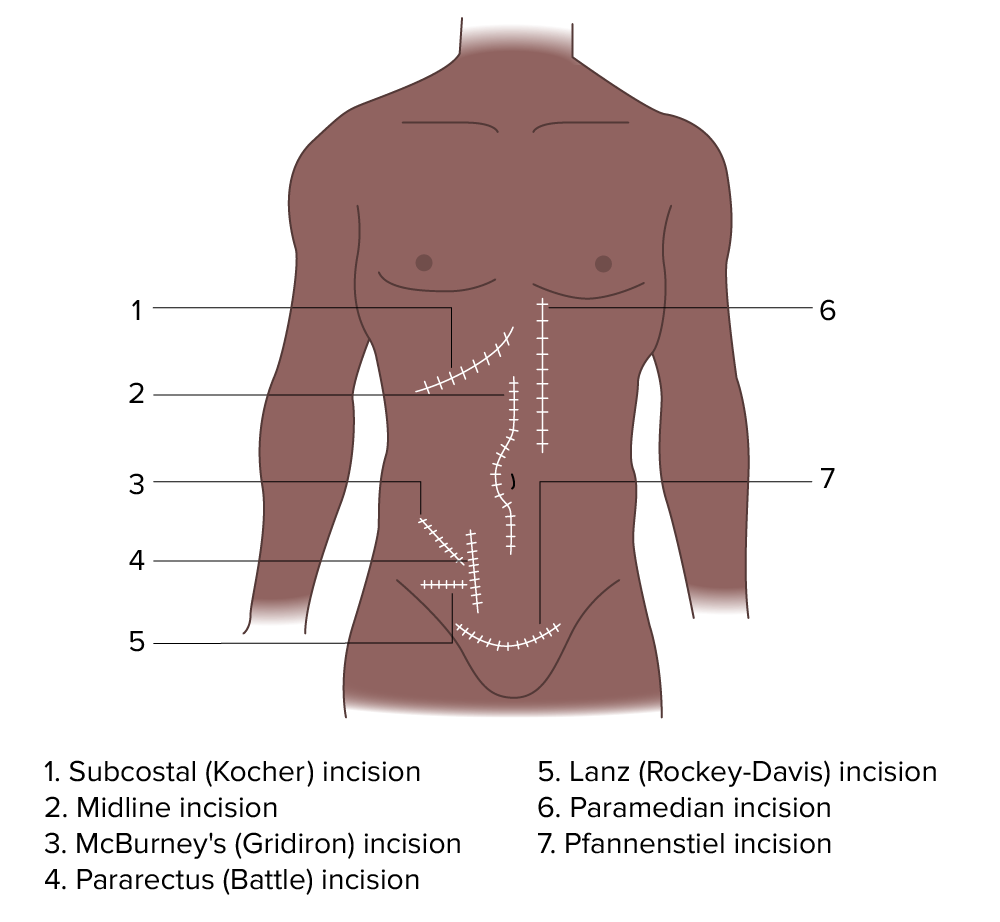
Location of surgical incisions
Image by Lecturio.Laparoscopy:
The main goal of the procedure is to achieve the same results as with an open approach, but less invasively. The quality Quality Activities and programs intended to assure or improve the quality of care in either a defined medical setting or a program. The concept includes the assessment or evaluation of the quality of care; identification of problems or shortcomings in the delivery of care; designing activities to overcome these deficiencies; and follow-up monitoring to ensure effectiveness of corrective steps. Quality Measurement and Improvement of surgical intervention should never be sacrificed, though, and the procedure can be converted to an open one at any point, as necessary.

Laparoscopic intervention of the abdomen:
Ports for the insertion of instruments are shown.
Some complications are specific to the intervention performed (i.e., cholecystectomy Cholecystectomy Cholecystectomy is a surgical procedure performed with the goal of resecting and extracting the gallbladder. It is one of the most common abdominal surgeries performed in the Western world. Cholecystectomy is performed for symptomatic cholelithiasis, cholecystitis, gallbladder polyps > 0.5 cm, porcelain gallbladder, choledocholithiasis and gallstone pancreatitis, and rarely, for gallbladder cancer. Cholecystectomy or appendectomy Appendectomy Appendectomy is an invasive surgical procedure performed with the goal of resecting and extracting the vermiform appendix through either an open or a laparoscopic approach. The most common indication is acute appendicitis. Appendectomy). However, some complications are common to all procedures.
Laparotomy is associated with higher rates of: